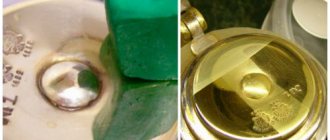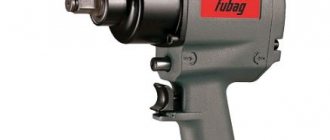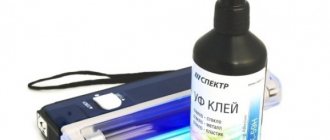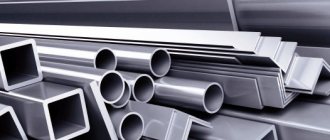No matter how much a car enthusiast protects his iron friend, defects and various scratches will inevitably appear on the windshield. The appearance of such lesions is due to the influence of an aggressive environment or due to mild mechanical influences. Depending on the depth of damage, defects can be divided into three categories: small, medium and large. Glass polishing paste will help eliminate them.
Damage options
In the first two to three years of operation of the car, the first minor defects begin to appear on the windshield of the car in the form of small scratches and chips no more than 200 micrometers deep. Often such damage occurs in the area of the wipers. Small scratches can be removed using a felt wheel and fine-grained paste. When polishing a windshield, a top layer about one micron thick is removed.
Defects with a depth of 200-300 microns are considered medium; such scratches are eliminated in several steps. During the first stage, correction is carried out with coarse-grained products based on zirconium dioxide and iron oxide. During the second stage, the final polishing of the car glass is done with fine-grained polishing pastes.
Scratches with a depth of more than 300 microns are considered deep. Their elimination is a rather complex and time-consuming procedure that requires the use of colorless photopolymer materials, and also requires coarse-grained polishing pastes based on chromium and cerium oxides.
When grinding a windshield, you cannot remove a layer of more than twenty micrometers. As a result of such improper processing, the glass becomes wavy and turns into something like a lens, and driving such a car is very dangerous.
First, repeated sanding is carried out with a coarse-grained polishing paste, then final polishing using a fine-grained paste.
Popular PP brands on the Russian market
In Russia there are many factory brands of PP on sale, which may have strong differences. Below we will look at several popular brands of pastes.
VMP Classic
The most popular brand of lapping abrasives on the Russian market. This material can be used to treat both diesel and gasoline engines. Can be used for both rough and final finishing. The average grain size is 70-90 micrometers, but during processing the grain is reduced by 5-10 times, which is a big plus (this ensures the versatility of the paste). PP does not deteriorate during storage and is easy to use. The brand is available in the form of plastic tubes with a spout, as well as in bags. The cost of a large tube weighing 400 grams is 700-800 rubles.
VMP Professional
It is an improved modification of the previous brand. Suitable only for treating gasoline engines (for treating diesel engines, it is recommended to use another brand of VMP Almaznaya). Can be used for roughing or finishing. The average fraction size is 45-75 micrometers, and during processing the fractions decrease in size. The brand is professional - it can be used to treat engines of both simple cars and racing ones. You can also rub the valves of trucks, buses, and various military equipment with the paste. The paste is available in the form of tubes and also in bags. The cost of a tube weighing 400 grams ranges from 900 to 1200 rubles.
VMP Diamond
This brand of PP contains diamond chips. Therefore, it can be used to process durable diesel engines. But it is not recommended to use it for grouting gasoline engines - grains of the material will leave scratches, which can lead to cracking of the valves. The grade is used for roughing or finishing. PP is not recommended to be mixed with other compounds. Available in four different varieties (tubes with composition + 1 kg bag). The cost of a large tube weighing 400 grams ranges from 1300 to 1800 rubles.
ABRO GP-201
ABRO GP-201 is available in the form of small jars, where the total weight of the two mixtures is 140 g. Each jar is divided into two sections:
- The first section contains COARSE paste. This composition is coarse-grained, and it is used for rough work, as well as for processing heavy-duty valves.
- The second section contains another PP, which is called FINE. This composition belongs to the category of fine-grained, and with its help final work is performed.
- Using PP is simple - first you use COARSE, and then use FINE. This processing method allows you to perform cleaning efficiently, conveniently, and quickly.
ABRO GP-201 does not deteriorate during storage. PP is classified as heat-resistant, so it can withstand high temperatures that a powerful engine can reach during operation. The cost of one such jar is 200-400 rubles.
Lapping and abrasive material Done Deal
The composition of this material is similar to ABRO GP-201 paste:
- The packaging is divided into two self-contained sections.
- The first section stores the universal medium-grain mixture.
- The second section stores the fine-grained mixture.
- For grouting, a person first uses a medium mixture, and then a fine one.
Done Deal is suitable for treating gasoline engines. The mixture does not contain large fractions, so it is not recommended for use on severely damaged valves. One package includes 2 identical tubes with a total weight of 50 g. The cost of one package is 300-500 rubles.
GOI
It is a lapping paste based on chromium oxide and stearin. Suitable for treating all petrol engines. The average cost of 1 package is 100-200 rubles. Available in three varieties depending on grain size:
- Experienced people should buy coarse and fine grain GOI, and the processing should be done in two stages.
- Beginners are advised to give preference to universal medium-grain PP, and processing can be done in one go.
Differences between grinding and polishing
In case of significant damage, a grinding procedure is performed. For independent use, this is a rather complicated process, since grinding is done with an emery wheel using an abrasive material. In the absence of experience, it is better to entrust this work to professionals.
In case of minor damage to the car glass, it will be enough to carry out the polishing procedure, which is performed using a special paste; mechanical processing is minimal.
What to consider when choosing a lapping paste
PPs differ from each other in a number of parameters.
Technical specifications:
- Grain size. This parameter is key. Coarse-grained compounds are used for rough grouting, as well as for processing parts made of durable metal alloys (alloy steel). However, coarse mixtures cannot be used to process parts that are in good condition - in this case, the mixture may create additional damage and microcracks. Fine-grained mixtures are suitable for finishing parts, as well as for working on valves that are in good condition. If the part is durable, then it will be difficult to use a fine-grained mixture. Beginners are advised to buy PP with a medium grain size - this paste processes all major alloys well, and the risk of defects is minimal.
- Composition of the material. To treat gasoline engines, standard mixtures without any additives are used. If you are dealing with a diesel engine, then you should buy a mixture that additionally contains diamond chips. Diesel engines are made of ultra-strong alloys, so they require a particularly sharp abrasive to process them. Clean the disk and seat of a diesel engine using a regular mixture, but for this you will have to make additional efforts, and the processing time will increase by 4-5 times.
- Price and quality. High-quality mixtures are easier to apply and take longer to harden after dilution. However, they also cost more. Cheaper mixtures should be used immediately after dilution, as they quickly harden and lose their useful technical properties. However, they can save you extra money, which can be important in some situations.
For auto repair shops, it is recommended to buy a large package - this will save extra money.
How to choose pasta?
Not every paste is suitable for polishing a windshield; when choosing it, you should give preference to a fine abrasive that will most likely not scratch the surface. One such product is 3M paste. The new product must first be tested on any suitable surface, and only then proceed with the polishing procedure.
Paste 3M 60150
This abrasive paste is designed to eliminate defects on silicate car glass. Main purpose:
- polishing minor scratches;
- removal of plaque and acid stains.
3M polishing paste is a creamy, white, water-based product that does not contain ammonium or silicone. The abrasive element is cerium oxide.
Mode of application:
- Prepare the surface - it must be cleaned with glass cleaner.
- Moisten a felt circle with water, then evenly apply two dessert spoons of 3M paste onto it.
- Wait until the polishing paste is absorbed and begin the polishing procedure. The speed of the machine should be 1200 rpm. You should remember to moisten the surface and periodically wet the felt circle on the back side.
- After completing the procedure, it is necessary to remove the remaining paste from the polished glass.
Water in glass polishing
When polishing a car's windshield, it is necessary to cool the surface with cold water in a timely manner. Clean tap water with a few drops of glass cleaning liquid is best.
Such a composition will simultaneously serve a dual purpose: to promote the polishing process and prevent heating of the polished surface. In this case, the glass should be only slightly wetted; a large amount of water will lead to hydroplaning.
The polishing procedure at home will take 3-4 hours, and will also require maximum patience. Polishing a windshield with paste will be much slower than polishing with 3TM wheels. But this procedure does not require additional surface cleaning. Polishing products will fall directly from the glass being polished into the polishing disc, which will prevent new scratches from appearing on the car glass.
Advantages and disadvantages
Products for treating glass and other automotive surfaces with the addition of diamonds have the following advantages:
- accuracy. The synthetic diamonds contained in the mixture will most accurately polish any surface, bringing it to the desired smoothness;
- Wide range of abrasiveness levels. There are 12 grit types that are suitable for any type of work;
- the ability to work with the material yourself. It is not necessary to go to a service station to polish glass or metal surfaces.
Preparatory stages of polishing
Before polishing, be sure to wash the car and inspect the workplace to prevent various small particles from getting onto the surface. Such carelessness can lead to deeper scratches during operation.
You must first protect the car from polishing paste by covering it with film. It is better to outline matte scratches and stains on the back side with a marker, this will make them easier to find during polishing.
Recommendations for polishing at home:
- during work, prevent small foreign particles from getting under the polishing wheel;
- polishing is carried out using uniform circular movements;
- you cannot stop at one area, as you can change the optics of the glass and create a lens effect;
- the movements of the grinding machine should be smooth, soft, and careful;
- it is necessary to constantly ensure that the surface being polished is sufficiently moistened;
- do not allow sections to be missed.
How to prepare PP yourself
How to make your own lapping paste. Below we will look at 2 main recipes that have proven effective in practice.
Recipe #1
To prepare you will need the following items:
- Several sharpening stones (2 or more). The abrasive must be fine. The shape of the stone can be any - circle, square, rectangle, oval.
- A clean work table or workbench. Before work, it is recommended to wash and dry the table. This will prevent water or third-party components from getting into the mixture.
- A large blank sheet of paper (A5 or A6 size). The paper is placed on a workbench or table (there may be microparticles of debris or dust on the surface of even the cleanest table).
- Low-viscosity, fluid motor oil. It is not recommended to use liquid varieties of oil - in this case, the quality of the mixture will be low, and processing will turn into torture.
- Plastic container with a large neck. The optimal container volume is 200-400 ml.
To prepare the paste mixture for lapping, place a clean sheet of paper on your workbench or workbench. Then place the first stone on top. Take the second stone in your hand and make forward-return movements with it along the first stone. As a result, you will form abrasive crumbs, which are needed for making paste. You only need to rub the stone against the stone very little - no more than 2 minutes. After this, carefully take a sheet of paper in your hand and pour the crumbs into a plastic container. Add machine oil to the container (the proportional ratio of oil and crumbs is one to one). Mix the mixture thoroughly until a homogeneous paste forms. The lapping paste is ready - it can be applied to the engine.
Recipe #2
Let's also look at an alternative recipe for making PP. We will need all the same elements as in the previous case - clean paper, a plastic container, oil, a table or workbench. The only important difference is that building bricks should be used instead of sharpening stones. Instead of solid bricks, you can use pieces of them (however, such pieces must have flat edges). The algorithm for preparing the grinding mixture will be almost identical:
- Clear the table of dust, wash it and dry it. Then place a blank sheet of paper on the table.
- Place a brick on a sheet of paper. Take the second brick in your other hand.
- Now you need to get brick chips - to do this, rub the second brick over the first.
- You should cut the brick for no more than 2-3 minutes - during this time the required amount of crumbs should form.
- Place the bricks aside, carefully take a sheet of paper and pour the crumbs into a plastic container.
- Pour machine oil into the crumbs in a ratio of 1 to 1. Stir the mixture until it becomes a homogeneous paste.
Diamond pastes
Diamond paste, which also comes in different grain sizes, is effective for polishing glass. You can apply it to the surface using felt cloth or a felt circle. Diamond paste is used from coarse to fine, and for each subsequent type, take a new fabric. According to GOST, such a product is divided into several types:
- coarse diamond paste (red);
- medium, usually green;
- blue diamond paste – fine-grained;
- thin yellow;
- white diamond - the smallest, for finishing.
This paste consists of diamond powder and binding components. There is also a lilac paste, it is the most coarse-grained, that is, the size of the diamond chips in it is the largest. It is usually used for rough finishing. In addition, diamond paste can be hard or soft.
What are the functions of lapping paste?
Any valve of an internal combustion engine consists of two structural elements - a plate and a stem. The plate looks like a flat disk, which is located at the end of the leg. It fits tightly to the seat on the motor (this place is called the saddle). The plate must fit snugly against the seat to ensure complete sealing of the connection. Such a strict requirement has a simple explanation - the closer the plate is located to the seat, the less heat loss from the engine will be and the higher the efficiency of the internal combustion engine will be. In an ideal scenario, heat loss tends to zero, and all the heat goes to perform useful work.
However, it is not always possible to achieve a tight fit of the plate to the seat. This problem is further complicated by the fact that in the case of long-term operation of the engine, minor damage, scale, and rust form on the surface of the valve plates, which leads to a decrease in the tightness of the connection. The longer the engine is operated, the more the tightness of the connection weakens. The use of PP allows solving the following engineering problems:
- Restoring natural sealing. In fact, PP is an abrasive, and during processing, rust, scale, chips, scratches, and burrs are removed. As a result of processing, the plate becomes smooth, straight, and uniform. This leads to a tighter fit of the plate to the seat, which increases the tightness.
- Reducing oil to waste. Additionally, the elimination of external defects ensures that no oil is ejected during engine operation. This reduces the amount of oil lost, which minimizes the risk of scale, soot, and rust formation.
- Restoring engine compression. Due to small defects on the surface of the compression disk, the efficiency of the engine decreases. Treatment allows you to restore natural compression, which also normalizes the level of engine efficiency.











